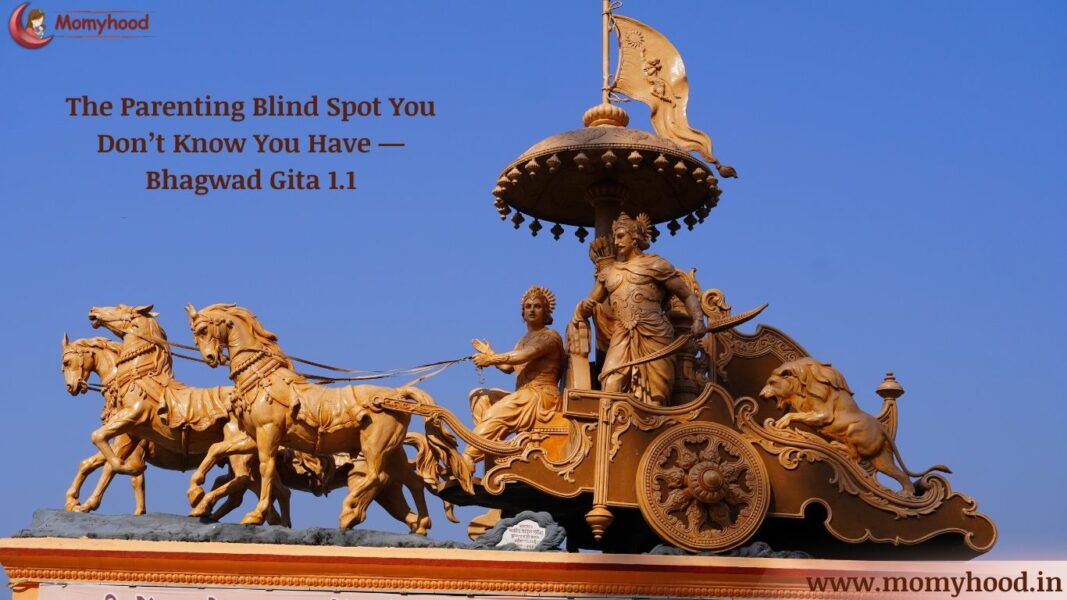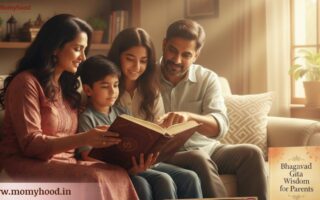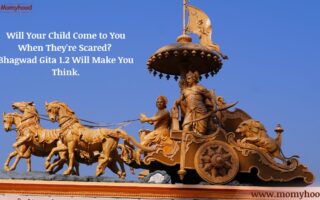”My Sons… and the Sons of Pandu”
The battlefield was set.
Chariots lined up. Conch shells echoed. And yet — before the war began, silence filled the air.
And in that silence, Bhagavad Gita begins — not with Lord Krishna, not with Arjuna — but with an old father’s question.
“Dhritarashtra said: O Sanjay, after gathering on the holy land of Kurukshetra and desiring to fight, what did my sons and the sons of Pandu do?”
— Bhagavad Gita 1.1
This one line — so simple at first glance — is packed with insight.
Because here, Dhritarashtra doesn’t say “our sons.”
He says:
“My sons… and the sons of Pandu.”
And right there… we see the first blind spot of the Gita.
Not just physical blindness — but emotional blindness.
A Subtle Choice of Words, A Loud Message
Dhritarashtra had 100 sons. But Pandavas were also his family — his brother’s children, who grew up in the same palace, called him uncle, and once sat at the same table.
📣 Loved what you read? Want to go deeper into conscious parenting? ✨ The Power of Manifestation in Parenting is now available — A soulful guide packed with real-life tools like affirmations, energy shifts, and sleep talk that I personally use with my son, Hitarth. 💛 Start your journey toward calmer, connected parenting today. 🎉 Launch Offer: Only ₹99 (limited-time price!) 📲 Instant download. No waiting. 👉 Grab your copy now!.
Yet, when it came to the battlefield… he separated them with just a few words.
“Mere bete… aur Pandu ke bete.”
Why?
Because attachment clouds judgment.
Because when our emotions are too strong, they make us see only what we want to see.
And This Happens in Parenting More Often Than We Realize
We don’t always do it consciously, but let’s reflect:
-
Have you ever found yourself defending your child’s mistake just because “woh mera bachcha hai”?
-
Do you ever compare your child to others — not in anger, but in frustration?
-
Have you ever appreciated your child less just because their talents or choices don’t match your expectations?
We all have.
And that’s what makes Bhagavad Gita’s opening so powerful.
Because it’s not just the start of a war story —
It’s the start of self-reflection.
Real-Life Example: When Comparison Sneaks In
A mother once shared with me:
“My younger daughter is quieter, more introverted. The older one is outgoing and confident. Without meaning to, I kept praising the elder in front of others. One day, my younger one asked, ‘Mumma, am I not smart like Didi?’ That broke me.”
This is how bias quietly shapes our children’s self-worth.
What Can We Learn From Dhritarashtra?
-
Watch your words – Sometimes, small phrases show big partiality. Like “My son is like this, but other kids…”
-
See the child, not your expectation – Every child has their own path. Don’t love them for what they do. Love them as they are.
-
Don’t divide their strengths and flaws – “He’s good at studies, but not responsible.” “She’s creative but not disciplined.”
These buts create inner division in your child. Instead, say, “You’re creative and learning responsibility.” -
Check your comparisons – Do you praise one child in front of the other often? Do you judge one more than the other?
A Verse for Us to Begin Our Inner Dialogue
It’s almost poetic that Bhagavad Gita begins with bias.
Because before Krishna speaks… before Arjuna breaks down… before the wisdom flows —
The Gita shows us something very human:
Change begins not with a big action… but with a small awareness.
And awareness begins with how we see.
Final Reflection
We don’t need to be perfect parents.
But we must be present and self-aware ones.
The way Dhritarashtra separated his own sons and nephews is how many of us unknowingly separate:
-
Strengths from flaws
-
This child from that child
-
Ours from “others”
But children notice. They feel it. And over time, these little cracks shape how they see themselves.
Let’s choose fairness over favoritism.
Let’s parent from clarity, not attachment.
And let’s begin our own Gita — not in a battlefield, but in the quiet moments with our children.
💬 Have you ever caught yourself being unknowingly biased as a parent? How did you reflect and shift? Share your story below — you never know who it might help. 💛
Your comments and shares do more than just support our blog—they uplift the amazing moms who share their stories here. Please scroll down to the end of the page to leave your thoughts, and use the buttons just below this line to share. Your support makes a big difference!


